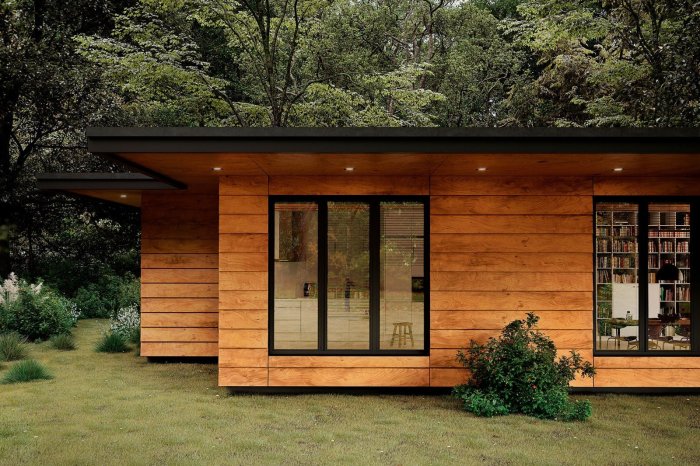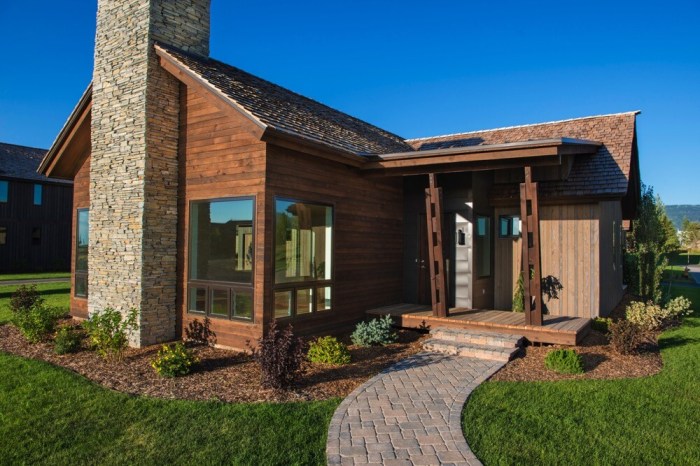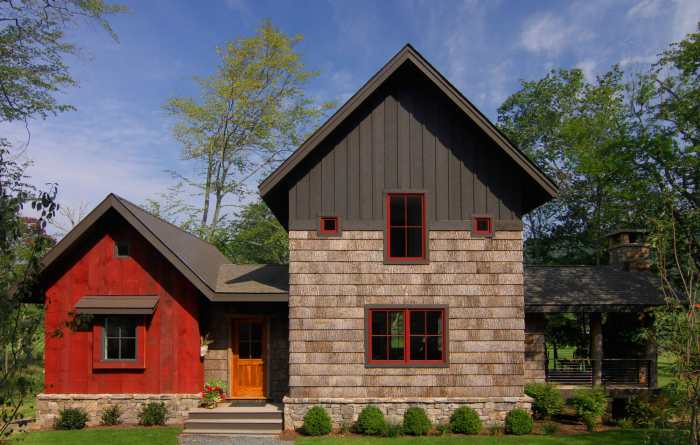Delving into natural wood siding houses, this introduction immerses readers in a unique and compelling narrative. From the durability and aesthetic appeal to the eco-friendly aspects, natural wood siding offers a blend of style and sustainability that is hard to match.
As we journey through the different types of wood, installation processes, and maintenance tips, you'll gain a deeper understanding of how to enhance the beauty and longevity of your home with natural wood siding.
Benefits of Natural Wood Siding
Natural wood siding offers a range of benefits that make it a popular choice for homeowners.
Durability of Natural Wood Siding
One of the key advantages of natural wood siding is its durability. When properly maintained, natural wood siding can last for decades, withstanding harsh weather conditions and providing long-term protection for your home.
Aesthetic Appeal of Natural Wood Siding
Natural wood siding adds a timeless and elegant look to any home. The rich textures and natural colors of wood create a warm and inviting atmosphere, enhancing the overall curb appeal of your property.
Eco-Friendly Aspects of Using Natural Wood Siding
Choosing natural wood siding can also be a sustainable choice for environmentally conscious homeowners. Wood is a renewable resource that can be sourced responsibly, making it an eco-friendly option compared to synthetic materials. Additionally, wood siding is biodegradable and has a lower carbon footprint compared to other building materials.
Types of Wood for Siding

When choosing natural wood siding for your house, it's essential to consider the type of wood that will best suit your needs. Different wood species offer unique characteristics in terms of appearance and maintenance requirements.
Cedar
Cedar is a popular choice for wood siding due to its natural resistance to decay and insects. It has a straight grain pattern and comes in various shades of red and brown. Cedar requires regular maintenance, including staining or sealing every few years to maintain its appearance and durability.
Pine
Pine is another common wood option for siding, known for its affordability and availability. It has a more pronounced grain pattern compared to cedar and comes in lighter tones. However, pine is less durable than cedar and requires more frequent maintenance, such as painting or staining every few years to prevent rot and decay.
Redwood
Redwood is a premium choice for wood siding, prized for its rich red tones and straight grain patterns. It is naturally resistant to decay and insects, making it a low-maintenance option for siding. Redwood can last for decades without the need for frequent maintenance, although applying a protective finish every few years can help preserve its color and integrity.
Installation Process

Installing natural wood siding on a house requires careful attention to detail to ensure a long-lasting and visually appealing result. Below are the steps involved in the installation process:
Surface Preparation
Before installing the wood siding, it is crucial to prepare the surface properly. This includes:
- Clean the surface thoroughly to remove any dirt, debris, or old paint.
- Repair any damaged areas, such as rot or cracks, to ensure a smooth and even surface.
- Apply a weather-resistant barrier, such as house wrap, to protect the underlying structure from moisture.
Installation Steps
- Start by measuring and cutting the wood siding to fit the dimensions of the house.
- Begin installing the siding from the bottom up, ensuring each piece overlaps the one below it to prevent water infiltration.
- Use galvanized nails or screws to secure the siding to the house, making sure to leave space for expansion and contraction.
- Continue this process until the entire house is covered with wood siding.
Sealing and Finishing
Proper sealing and finishing techniques are essential to protect the wood siding from the elements and ensure its longevity. This includes:
- Applying a high-quality primer to seal the wood and prevent moisture penetration.
- Using a breathable finish, such as stain or paint, to protect the wood from UV rays and water damage.
- Regular maintenance, such as cleaning and reapplying finish as needed, to keep the wood siding looking its best.
Maintenance and Care
Proper maintenance is crucial for preserving the beauty and longevity of natural wood siding. By following a routine maintenance schedule and taking preventive measures, you can protect your wood siding from potential damage.
Protecting Wood Siding
- Ensure proper ventilation to prevent moisture buildup, which can lead to mold and rot.
- Regularly inspect for any signs of pests like termites or carpenter ants, and address any infestations promptly.
- Apply a quality wood finish or sealant to protect against UV rays and weathering.
- Trim any nearby trees or bushes to prevent contact with the siding, reducing the risk of scratches or damage.
DIY Cleaning Methods
- Mix a solution of mild detergent and water, and gently scrub the siding with a soft brush or cloth to remove dirt and grime.
- Rinse thoroughly with water to ensure all soap residue is removed.
- For tougher stains, consider using a specialized wood cleaner following the manufacturer's instructions.
- Avoid using high-pressure washers, as they can damage the wood fibers and finish.
Final Wrap-Up

In conclusion, natural wood siding houses not only provide a timeless charm to any home but also offer a sustainable choice that can withstand the test of time. By following the right maintenance and care routines, you can ensure your natural wood siding remains a stunning feature of your residence for years to come.
FAQ Explained
What are the benefits of natural wood siding?
Natural wood siding is durable, aesthetically pleasing, and eco-friendly, making it a popular choice for homeowners looking for both style and sustainability.
Which types of wood are commonly used for siding?
Popular wood options for siding include cedar, pine, and redwood, each with unique characteristics in terms of grain patterns and colors.
How can I protect wood siding from moisture and pests?
Proper sealing and finishing techniques, along with regular maintenance, can help protect wood siding from moisture, pests, and UV damage.
What maintenance is required for natural wood siding?
Regular cleaning, sealing, and inspections are essential for maintaining the beauty and longevity of natural wood siding.







